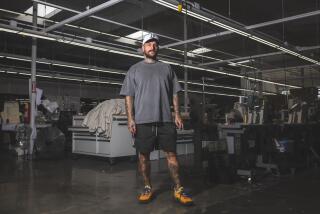Sock Maker Knits Niche in U.S. Sales : Apparel: While many plants move abroad for cheap labor, Mountain High Hosiery finds advantage in filling orders extremely rapidly.
When San Diego-based Mountain High Hosiery sued the U.S. Immigration and Naturalization Service earlier this month, challenging the methods that Border Patrol agents used in a 1991 raid, it said it was just trying to protect its workers from discrimination.
The issue is important to Mountain High because 60% to 65% of its 300-person work force comes from predominantly minority neighborhoods in Southeast San Diego.
The INS âcame into the raid, asking all the Latino-looking employees for documentation and ignored the Anglos. It showed they were being selective,â said Tom Brown, vice president of operations. Mountain High contends that most of the employees the INS said were working illegally were later found to be legal.
Privately held Mountain High is one of the countryâs leading sock manufacturers, producing more than 800,000 pairs of socks a month. It expects to reach $30 million in sales this year. The socks, which retail at prices ranging from $5 to $12.50 a pair, are sold under national labels as well as under its own label, Mountain High Knitting.
And, although it may be spending some time in court fighting the INS, Mountain High co-founder Michael Speyer says that wonât deter the company from its high-growth course.
âWe do everything here in Southeast San Diego,â Speyer said from his companyâs headquarters in Gateway Center just off California 94. While many apparel manufacturers have moved their whole operations abroad in search of cheaper labor, Speyer says, Mountain High is âsuccessful, believe it or not, because weâre manufacturing here in the United States.â According to Brown, Mountain High workers earn $5 to $16 an hour.
The key to his companyâs success is âquick turnaroundâ--the ability to fill orders from retailers extremely rapidly. Mountain Highâs in-house labor force, ranging from designers to toe-stitchers, can turn yarn into menâs, womenâs and childrenâs socks in less than 36 hours.
âThe ability to work with local domestic suppliers is a definite advantage,â said Sid Smith, president of the National Assn. of Hosiery Manufacturers. According to Smith, six-month lead times in making orders and long delays in shipments make retailers wary of importing from manufacturing giants South Korea and Taiwan.
âA domestic manufacturer can offset long lead times and delays,â Smith said.
For those reasons, imports of socks into the United States fell by 24% in 1991, Smith said. Retailers bought $63 million worth of imported socks last year, just a fraction of the sock industryâs $2.5-billion total retail value.
According to Smith, companies such as Mountain High that emphasize technology, styling and marketing have played a key role in the decline of imports.
Case in point: When buying overseas, companies commit to fashions that can change during the long lead time between orders and delivery. If fashions change, the retailer suffers, Speyer said.
To stay abreast of fashions, Speyer employs a state-of-the-art design process.
Mountain Highâs seven full-time designers can either create original designs on computers or scan and copy pre-existing patterns. Colors are reproduced on a $50,000 computerized copier, complete with 2 million color capabilities, including 100,000 shades of Navy blue. Speyer said that if a client wants socks to match his ties, his computers can easily duplicate any color and design.
Patterns are stored on computer discs and transferred to cassette tapes. The tapes âplayâ on the automated knitting machines, directing knitting maneuvers that usually employ several different materials in varying colors.
Speyer and his partner, Frank Lucia, have created what Speyer calls âa completely verticalâ operation. From the minute they receive an order, to the time it leaves their shipping dock, all of the manufacturing is done in-house, Speyer said. If a color or pattern turns out wrong on samples, whole orders can be saved with just a few software changes.
The sluggish economy and financial problems of many retailers have forced them to initiate self-imposed austerity measures, Smith said, measures that have worked to Mountain Highâs advantage.
For a cash-strapped retailer wary of immovable inventory, a net 30 days purchasing agreement with Mountain High seems more sensible than an overseas order prepaid six months in advance, Speyer said.
âThe retailers want as little money as possible invested in inventory,â Speyer said. âThey donât want to tie up their cashâ or have yesterdayâs fashions collecting dust on their shelves, Speyer said.
Along with current market conditions, Speyer said that his companyâs moderate size has been another asset. âWe can make a decision without having a board meeting,â he said.
For Mountain High, the future includes possible ventures into Mexico and Europe.
Smith said a pair of menâs dress socks are being sells for $20 to $40 in Europe. And, in Mexico, Speyer said, there are âa lot of people who can buy this kind of product.â
According to Smith, about 25% of all sock purchases are made in department stores and national chain stores, Mountain Highâs chief customers. With that in mind, Smith said, companies like Mountain High are postured well for the future.
âThe biggest challenge facing the American hosiery industry is not imports,â Smith said. âThe biggest short-term challenge is the difficult turmoil that the retail industry is going through in America.â
Once the economy gets back on the upswing, Smith said, domestic sock manufacturers will reap the benefits.
âAs the retailers get well, we (domestic producers) will be their partners of choice. The quality and styling we are putting out is superior to what one can get in any part of the world,â Smith said.
More to Read
Inside the business of entertainment
The Wide Shot brings you news, analysis and insights on everything from streaming wars to production â and what it all means for the future.
You may occasionally receive promotional content from the Los Angeles Times.










